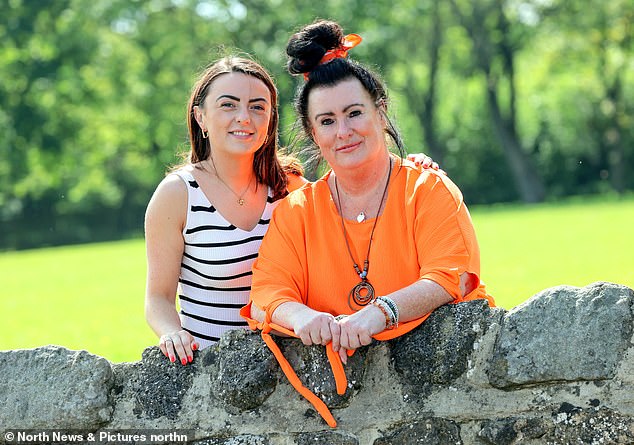According to experts, GPs often overlook the warning signs of bladder cancer and mistakenly dismiss them as urinary infections, menopause symptoms and gynecological problems.
It is claimed that the outdated guidelines mean that women under 55 will, on average, have to visit their doctor several times with the same complaints before being referred for diagnostic investigations for bladder cancer.
With a recent survey showing that two-thirds of bladder cancer patients were initially misdiagnosed with another condition, concerns are being raised that delays are costing lives.
“We know from studies that women with bladder cancer have gone to the doctor complaining of symptoms five times, on average, before being referred to a specialist,” says Dr Alison Birtle, a consultant clinical oncologist specializing in urological cancer.
Helyn Glover from Sunderland whose bladder cancer was initially misdiagnosed (pictured with her daughter Amy)
“But a single episode of blood in the urine should trigger that referral.
‘There is a perception that younger women don’t get bladder cancer, but I have treated many women who were diagnosed in their 20s and 30s.
“GP guidelines recommend not referring women under 45, but this is based on old historical data and we need to consider that anyone can get the disease, rather than having this widespread non-referral.”
In addition to blood in the urine, symptoms of bladder cancer include more frequent and painful urination, unexplained weight loss, fatigue, incontinence, and abdominal pain.
About 10,000 people are diagnosed with the disease each year, and 80 percent of cases occur in people over 65 years of age. It is related to smoking and is three times more likely to occur in men than in women.
However, Dr Lydia Makaroff, chief executive of the charity Fight Bladder Cancer, says that more and more phone appointments with the GP mean many women are mistakenly being prescribed antibiotics to treat a urinary tract infection ( UTI), without undergoing a simple test to rule out said infection. and point out possible signs of cancer.
“Women wait longer than men to receive a diagnosis, and younger women wait the longest,” says Dr. Makaroff.
‘When a patient has a suspected UTI, a urine test should be performed to confirm the diagnosis. But this does not happen, even when patients return a second time.
“This means that women often find themselves in a cycle of misdiagnosis and experience critical delays in treatment.”
Experts say a lack of awareness, stigma around symptoms, few treatment options and being wrongly considered a disease of older people means bladder cancer has become a “disease of the elderly.” Cinderella,” ignored for research funding, celebrity endorsements, and the public. awareness.

A recent survey showed that two-thirds of bladder cancer patients were initially misdiagnosed with another condition (file image)
However, in recent years, innovative treatments have increased survival rates.
In one trial, patients with incurable bladder cancer who received the antibody drug enfortumab vedotin with immunotherapy treatment with pembrolizumab lived twice as long as those who received standard chemotherapy. A third ended up with no signs of illness.
Later this year, the treatment will be submitted to NHS spending watchdogs for approval.
“It will be extremely disappointing for patients and doctors if it is not approved,” adds Dr Birtle.
Professor Thomas Powles, director of Barts Cancer Center and a specialist in the treatment of bladder cancer who led the trial, added: “I think we are going to cure a large number of patients (with this treatment). I have been involved in many trials. throughout my career, but this seems the most transformative and exciting.”
Separately, US pharmaceutical company MSD is conducting a “cancer vaccine” trial targeting patients with muscle-invasive bladder cancer, which was recently successfully tested in people with melanoma, a type of skin cancer. .
And Professor Simon Crabb, from the University of Southampton, is leading the £3m Gusto trial seeking a personalized cancer treatment.
By examining the “gene expression” of 320 patients, the team hopes to determine which treatment responds best: whether chemotherapy, immunotherapy or surgery.
But despite exciting advances, Dr Birtle says getting a diagnosis and treatment remains a constant struggle.
‘I feel that in the 20 years I have been a consultant, it always seems to be an uphill battle for our bladder cancer patients, and many of them are very young.
“Until we review national GP guidelines and change things, we will be failing our patients.”
What is the difference… between tachycardia and tachypnea?
Tachycardia refers to an abnormally fast heart rate, defined as more than 100 beats per minute at rest.
It can be caused by heart disease, anemia, stress, anxiety, and stimulant use.
Symptoms include rapid pulse, heart palpitations, difficulty breathing, dizziness, and chest pain.
It is rarely life-threatening and treatment may include medications to slow the heart or cardioversion (an electrical shock to return the heart to its normal rhythm).
Tachypnea refers to rapid breathing and may include wheezing or coughing.
Treatment focuses on the cause, such as inhalers for asthma or antibiotics for pneumonia. Severe cases may require an oxygen mask.


